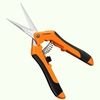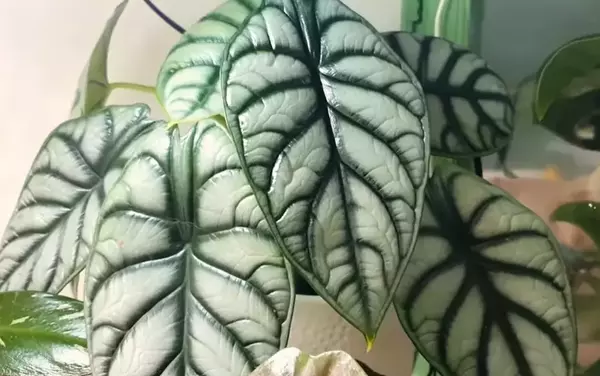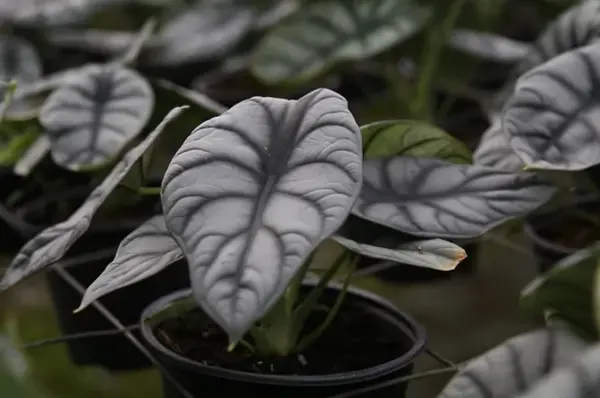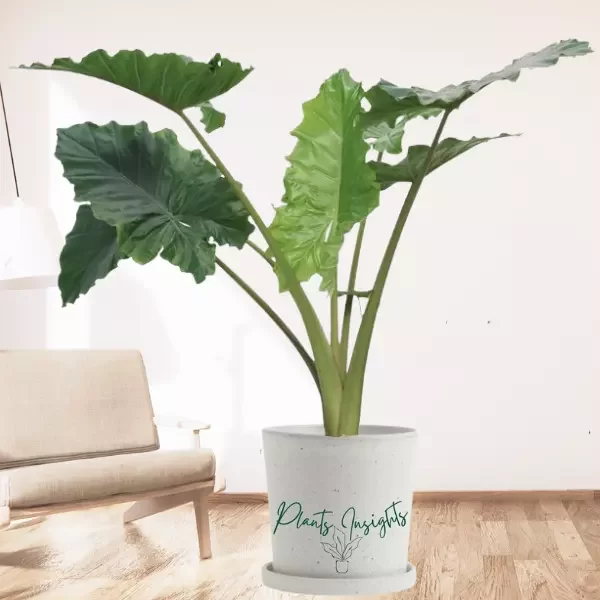Silver Dragon Alocasia (Alocasia Baginda ‘Silver Dragon’) is highly sought-after and adored tropical house plant among plant parents due to it’s stunning highly textured silver green foliage. The main highlight of Alocasia Baginda is the heart-shaped thick leaves exhibiting extraordinary and rare silvery colour contrasting dark green venation. The texture enhances its appearance along with foliage on its surface. Dragon Alocasia belongs to the family Aroid and is a most prominent part of the “Alocasia Jewel family”. Alocasia Dragon silver and Alocasia Dragon Scale both are variants of Alocasia Baginda. The plant is incredibly fascinating because of its peculiarity. Moreover, the foliage on its surface looks more like silver dragon scales.
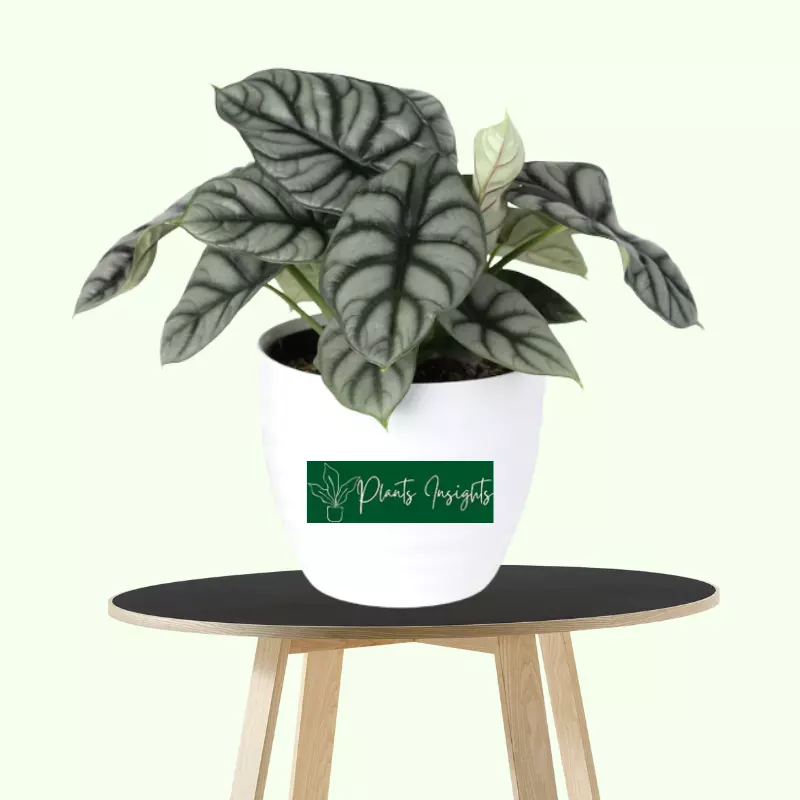
This extraordinary plant is a relatively compact plant that grows up to two feet tall and the same width. The fascinating silvery leaves reach a length of eight inches with a width of six inches. On the whole, it is a phenomenal household pant, and with time, it is gaining popularity among collectors. This variant of the plant species is native to Indonesia, Borneo.
Allied Species: Baginda Dragon Scale, Alocasia Azlanii, Alocasia Bisma, Alocasia Black Velvet, Alocasia Pink Dragon, Alocasia Stingray, Alocasia Cuprea ,Alocasia Maharani.
Essential Products
Habitat & Ecology
| Botanical Name: | Alocasia “Baginda” |
| Family Name: | Araceae |
| Common names: | Alocasia Silver Dragon, Silver Dragon Alocasia |
| Plant type: | Tropical flowering perennial plant |
| Origin: | Native to Indonesia |
| Bloom: | White |
| Height: | 2 feet |
| Humidity: | 50%-80%. |
| Temperature: | 60°F-80°F (15 to 26 degrees Celsius) |
| Light Need | Bright, indirect light |
How do you take care of a Silver Alocasia Dragon?
The care aspect for the exceptional or uncommon fascinating plant includes various factors. To keep them breathing and well-maintained, you need to look for multiple factors including light, temperature, watering etc.
The Alocasia Silver Dragon is not suggested for beginner gardeners. Because it requires concise care to remain alive in its early days, thus, you should stick to the care schedule the plant needs, especially in starting days. That’s why we recommend the people with some gardening know how to plant the Silver Dragon Alocasia.

Alocasia Baginda Early Care
To master up as a Gardner for Silver Dragon Alocasia care is not easy. Although it is a household plant species, it requires highly professional care. Along with applying the best practices of houseplant care, provide the Silver Dragon plant with the right atmospheric conditions.
Under the right circumstances, your Alocasia Silver Dragon plant’s flower will sprout or bloom. These blossoming flowers will highlight a spathe and spadix. The leaves usually cover them up. In comparison, the foliage of Alocasia is a genuine masterpiece.
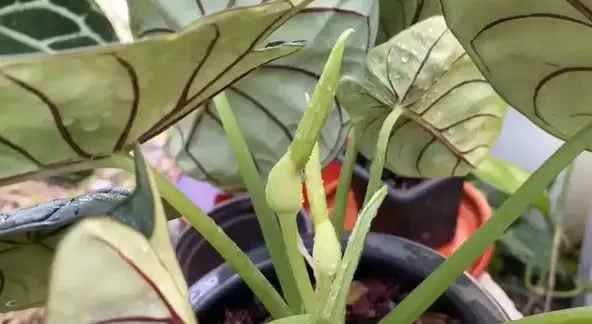
Many plant parents become overwhelmed with the addition of new plants to their inventory and skip the necessary checks. Before putting it with other houseplants, please thoroughly inspect the new AloCasia Silver Dragon for any sign of infestation and disease.
A new houseplant, if infected, can transfer pests and diseases to your other houseplants. Therefore we recommend keeping your Alocasia Silver Dragon isolated from other houseplants for at least two weeks. This quarantine period is necessary to rule out the risk of spreading any underlying disease.

Lighting Requirements
The best lighting for a Silver Alocasia is bright light; however, don’t place it in direct sunlight. Because natural daylight will burn the foliage of Alocasia Silver, they will bloom and flourish near bright sunlight receiving windows.
Keep them out of the reach of direct sun rays or isolate them from direct sunlight by using a window blind or a sheer shade to cover them up.
On an estimation, try to keep them roughly two feet aside from a northeast-bound window. But it is essential to draw it nearer to the window in winter to boost lighting.
– Keep rotating the Silver Alocasia regularly to ensure that all sides of the plant receive uniform light. Turn the pot at 90º in a clockwise direction before watering the plant. It counts as a simple technique to manage things.
– If you have placed the Silver Alocasia pot outside, the plant needs an obscure spot with shade. It protects the plant from the intensity of light during the day.
– Indoors, artificial lighting might be very compelling.

How often do you water Alocasia Silver Dragon?
An accurate watering schedule is crucial to developing Alocasia Silver Dragon plants effectively. They don’t survive over watering or water shortage. When the soil turns out to be too dry, the tips of the leaves could become brown or curl.
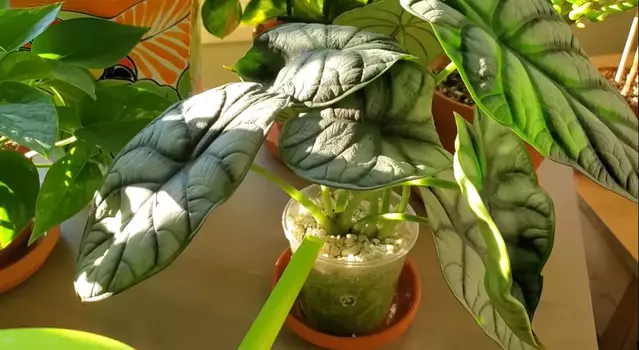
Knowing moist and wet soil is essential to keep the Dragon Alocasia plant thriving. The moisture level is ideal when the base portion of the substrate is marginally wet. It must not be overly wet or dry. On the whole discussion level, accurate watering schedules rely upon various factors. These factors include temperature, a measure of daylight, the season, and the soil type.
The Alocasia Silver Dragon plant will become sluggish or dormant when the temperature plunges, and there is less steady light during winters. As the ambient temperature changes, the water cycle will require adjustment accordingly.
It will not develop any new leaves while the plant draws energy for the impending developing season. Therefore, the Gardener should water the plant once each week or like clockwork during this stage.
Spring to pre-winter is particularly a difficult development period for this plant. So at this time, it is better to water the Alocasia Silver Dragon plant two to three times each week. Because during these atmospheric changes, the soil is dry to almost 1-2 inches and plants need extra water.

Humidity and Temperature
Alocasia houseplants flourish with considerable humidity (50-80%), ensuring a native connection to subtropical regions. Setting the Alocasia Dragon Silver houseplant in a space with high humidity is very effective.
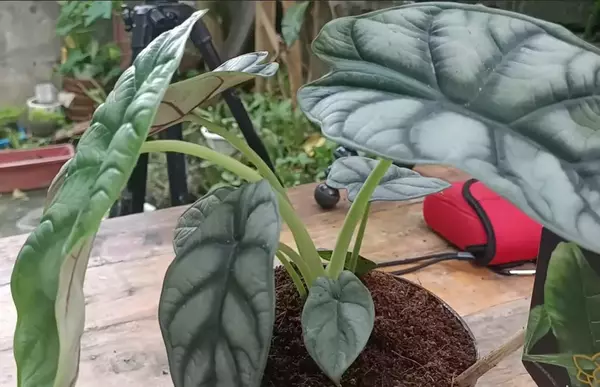
Various choices are available to assist you in providing the additional increase in humidity the plant looks for. You may use a humidifier to increase the humidity level around your Alocasia Dragon Silver. Other DIY techniques like pebble trays, grouping the plants and frequent misting are also helpful if you intend not to use a humidifier.
In addition, the temperature range that Dragon Alocasia can withstand is 60°F to almost 80°F. Cool-weather conditions can be a trigger for lethargy. The plant will quit developing and begin to look worn out. You can use a hygrometer to monitor humidity and temperature for better care.
Thus, keep your Alocasia Dragon protected from hot and cold extremes because both conditions will put the Alocasia Silver Dragon plant under great stress. It will cause the yellowing of leaves, and tips will start getting brown.

Fertilizer
Feeding the Silver Dragon Alocasia with a balanced fertilizer quantity is very significant. Add it to the pants once in six weeks, especially during the growing season. Since this plant does not require much feeding, overfertilization is more likely to happen rather than undernourishment.
Overfertilization can cause unused fertilizer to accumulate in the soil over the time. This unbalanced condition will harm the plant. As a result of harm, the leaves and tips start getting brown.
In case of accumulation of fertilizer and minerals in the soil, we recommend flushing the plant soil. The flush will remove the toxins and extra fertilizer from the soil. Please follow the following steps to flush the soil.

Soil Requirements
Appropriate growth and development of the Alocasia Dragon start with the proper condition of your soil. So their oxygen-cherishing roots can absorb the nutrient accurately. The plant requires moisture-retaining and well-draining soil with a good aeration quality.
Moreover, the soil for Alocasia Dragon plant must be rich in nutrients and adequately aerated. As far as the pH is concerned, it should be between 5.0-7.5.
We suggest a soil blend for the Alocasia Dragon Silver by mixing the following components;
- One part is Potting soil.
- One-part Perlite. You can replace pumice with Perlite for more efficient results.
- And one part peat moss. You can use Coco coir instead of peat moss if you want something more eco-friendly.
- Add some Horticultural charcoal.
You can also go with the addition of some peat, organic fertilizer, or quality gardening soil for richness and to manage the water-retaining property.

Repotting Alocasia Baginda
Repotting is, in a real sense, a pivotal point in a plant’s life cycle. In the case of the Alocasia Dragon plant, it loses all its leaves and goes torpid after repotting. Try not to do it except if it is essential. Spring is the best chance to repot Dragon Alocasia. Repotting is vital to permit the roots to develop ceaselessly and for the new soil to restore the plant.
Once the plant has outgrown its container, usually in one to two years, it is the best time to replant in a new pot (transparent pot). However, the new pot shall be only one size bigger than the current pot, or it should be only a couple of inches more in measurement. Selecting a pot larger than the requirement can prompt overwatering and, therefore, shall be taken care of appropriately.
While repotting, we recommend using a loose and well-draining soil mixture. Concerning the pot, go up a size that is around two inches bigger in breadth than the ongoing pot. We recommend using a transparent plastic pot to help you monito the root growth. This size management helps in supporting the successful development of the plant.

How do you Propagate Alocasia Silver Dragon?
Alocasia Dragons doesn’t propagate through a leaf or stem cuttings. In actuality, the root clumps and side shoots can be partitioned and developed independently.
Regarding the time of propagation, we suggest propagating it at the time of repotting. Here are the procedural steps for the propagation of the Alocasia Dragon:
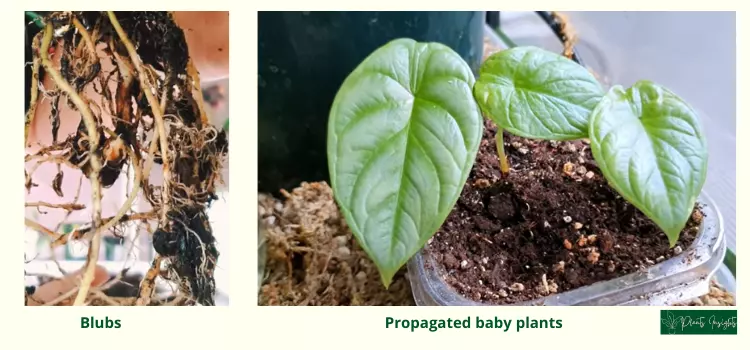
In addition, bulbils can be a propagative source for Dragon Alocasia. Bulbils are the extensions formed on the stem in the axils of a leaf. When they develop fully, detach them and press them in nutrient-rich, gritty soil.
Once the bulbil is grounded in the soil, keep it moist and add plenty of compost for better growth and development.

Cleaning and Pruning
The Alocasia Dragon Silver plant comprises various maintenance factors. The most common of these factors are cleaning and pruning. Alocasia Silver Dragons don’t require a lot of pruning because they develop in a rosette.
It would help to eliminate withered, harmed, or infected leaves for better appearance and growth. The pruning is very effective as it increases the airflow. This airflow keeps the bacteria and fungi away from attacking the plant.
In addition to this, the Alocasia Silver Dragon is a relatively small plant, so try to clean the leaves regularly. For cleaning the leaves, use a soft, damp cloth. This wet cloth will remove the dust and align the leaves with moisture.

Is Alocasia Silver Dragon Poisonous?
The Dragon Alocasia is a toxic plant; therefore, please take proper care to keep kids and pets safe from the plant. Silver Dragon Alocasia is lined with insoluble calcium oxalate, which is unsuitable for the digestive system.
Majorly it can be a source of dermatitis. It eventually disrupts the standard functionality of the stomach and the digestive system.

Pests, and Diseases
Pests
Outdoor Alocasia Dragon is most likely to be the victim of the pest. The fundamental or most popular pest agents attracted by this toxic Dragon Alocasia are aphids, scales, coarse bugs, and other kinds of bug parasites.
Bug parasites are very hard to remove once the target is settled.
Prevention
You can avoid these dangers and invasions by showering the plant entirely with warm, sanitized water regularly or consistently. The only and the best cure for pest release is prevention!
Similar soap water treatment can win from the Alocasia Dragon invasion. Moreover, various Insecticidal cleansers are available. They kill bugs on contact, so spray the plant entirely with the cleaners and solutions. Repeat the process regularly for the best result.
The pest invasion can cause several diseases if it spreads. These might be harmful to human beings.
Diseases
The most common disease for the Silver Dragon plant is the leaf spot. It can either be a side effect of numerous illnesses. Apart from the pest attack on Dragon Alocasia, it may be brought about by various microbes, including Xanthomonas bacteria.
Limiting the abundance of moisture from overwatering, moistening, or wet leaves will assist with forestalling and spreading contamination.
If you find any of the disease’s symptoms or sickness, isolate the plant from other houseplants to prevent the additional spread. Securely dispose of impacted leaves and clean your instruments with sanitizing liquid.
FAQs
Is Silver Dragon Alocasia Native to Asia?
Silver Dragon Alocasia is a plant species that belongs to the Alocasia “Jewel” “plant. Ll, the subordinative plant segments of Jewel Alocasia are genuinely native to Asia. That’s why they are called Alocasia Nebula.
Is the worth of Dragon Alocasia?
Alocasia Dragon is exceptionally famous and costly in terms of price and availability. The leaves of a mature Alocasia have a lovely silvery green tone and you may have to pay up to fifty dollars for it.
Is Alocasia Silver Dragon Same as Dragon Scale?
Alocasia Silver Dragona and Alocasia Dragon Scale are not the same plants. However, both are varieties of Alocasia Baginda. The Dragon Scale’s foliage is dark green compared o Silver Dragon. Whereas, as the name depicts, Silver Dragon leaves have a silvery tone.
Why are my Silver Dragon leaves turning yellow?
Overwatering is the most common cause of leaves yellowing in the case of Alocasia Silver Dragon. It means either you water the plant more than it requires, or the soil is compact and not well-draining.
There could be other reasons like root rot and pest attack that may cause the yellowing of leaves.
Why is my Alocasia Silver Dragon drooping?
Drooping leaves mean the plant is not receiving enough water and is dehydrated. Exposure to extreme temperatures and undesirable humidity may result in drooping leaves.
Water the plant if the soil is dry and provides the plant with favorable ambient conditions to recover.
Conclusion
Silver Dragon Alocasia has both its desirable and undesirable factors. It is a household plant with a fascinating appearance. But the calcium oxalate makes it unfriendly for the kid’s experience.
Overall, it is a gorgeous plant because of its Silvery foliage. We try to present the most comprehensive info guide about the Silver Dragon Alocasia plant. But still, if you have some queries, feel free to ask in the comment box or contact us.
Related Posts
Alocasia Calidora | Elephant Ear (Persian Palm) Care
Alocasia Calidora is a cultivar featuring large ruffled edged attractive leaves. Owing to large foliage got the name ‘Calidora’ Elephant ear.
Alocasia Portodora (Upright Elephant Ear) Care Guide
Alocasia Portodora is a stunning plant with its lush, glossy green tropical leaves, and inviting looks also called Upright Elephant Ear plant.
Alocasia Black Velvet | Alocasia Reginula Care & Propagation Tips
Alocasia Black Velvet (Alocasia Reginula) stands out among all because of its stylish appearance ,texture and compact growth habits.
Alocasia Melo | Alocasia Rugosa Care and Propagation Tips
Alocasia Melo is a beautiful plant with large textured leaves and lush foliage- jade or greenish-blue leaves up to 20” tall.
Alocasia Cuprea (Mirror Plant ) | Red Secret Alocasia
A lovely variant of Jewel Alocasias is the Alocasia Cuprea. It might need a little extra care and attention, but it will repay you with beautiful copper leaves.




